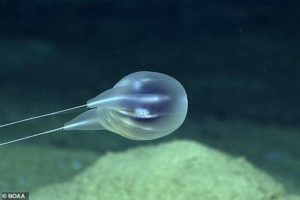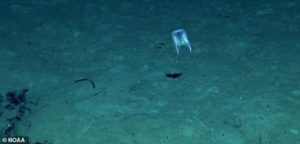Jan
17
New Species of Deep-Sea Blob Identified
Here’s a bit of relief from the political stuff goin’ on…

There are scads of interesting creatures under the sea, and some of them are rather bizarre-looking. For example, the lamprey, goblin shark, anglerfish, and blobfish are among my favorites. But, the “deep-sea blob” I want to bring to your attention today is not related to the blobfish. Rather it is a newly-discovered type of ctenophore. Nor is it closely related to jellyfish, despite its appearance and the fact that the common name for ctenophores is “comb jellies”.
Dubbed Duobrachium sparksae, this small marine invertebrate was initially discovered in April 2015 by the remotely operated vehicle (ROV) Deep Discoverer off the coast of Puerto Rico. And it was roughly 2.5 miles down!
Why did it take so long to announce the discovery? Well, the normal classification process involves extensive laboratory testing and examinations. But, no physical specimens of D. sparksae were collected, and the ROV wasn’t equipped to take tissue samples for genetic testing. Besides, it isn’t as if they could bring samples up to the surface for study. (Doing this to a denizen of the deep results in the lack of pressure and/or much warmer temperatures destroying it. Plus, “gelatinous animals don’t preserve very well.”)
All that the scientists from the U.S. National Oceanic and Atmospheric Administration (NOAA) had to work with were high-definition videos and images taken by the ROV and transmitted to the surface.
“It was a beautiful and unique organism. We collected high-definition video and described what we saw. We went through the historical knowledge of ctenophores and it seemed clear this was a new species and genus as well. We then worked to place it in the tree of life properly.” — Mike Ford, NOAA Fisheries scientist
The scientific team published their findings last year in the journal Plankton and Benthos Research. According to Allen Collins, marine biologist and Director of the NOAA’s National Systematics Laboratory:
“Video identification can be controversial. For example, some insect species descriptions have been done with low-quality imagery and some scientists have said they don’t think that’s a good way of doing things. But for this discovery, we didn’t get any pushback. It was a really good example of how to do it the right way with video.”

The videos/images were of such extremely high quality — able to identify structures of less than a millimeter — that they were able to identify reproductive parts and other details of the tiny creature’s morphology. Notably, this was “the first time NOAA scientists have exclusively used high-definition video to identify and describe a new creature.”
Based on the three individuals studied, this new “deep-sea blob” has a bulbous body (plus two “dangling bits”) measuring about 6cm long with two long tentacles reaching 30-56cm each. It floats about like a party balloon, presumably in search of prey, but then it extends those tentacles to apparently anchor it to the seabed and maintain its position. Oddly enough, from a certain angle the creature’s body even looks rectangular, which is also unique!
The wonders of God’s creation…
P.S. This article includes a nice, 4-minute video about the discovery.















